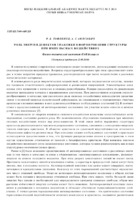| dc.contributor.author | Тофпенец, Р. Л. | ru |
| dc.contributor.author | Анисович, А. Г. | ru |
| dc.coverage.spatial | Минск | ru |
| dc.date.accessioned | 2019-10-26T08:20:14Z | |
| dc.date.available | 2019-10-26T08:20:14Z | |
| dc.date.issued | 2014 | |
| dc.identifier.citation | Тофпенец, Р. Л. Роль энергии дефектов упаковки в формировании структуры при импульсных воздействиях / Р. Л. Тофпенец, А. Г. Анисович // Весцi Нацыянальнай акадэмii навук Беларусi. Серыя фiзiка-тэхнiчных навук = Известия Национальной академии наук Беларуси. Серия физико-технических наук. – Минск : Белорусская наука. – 2014. – № 3. – С. 21-26. | ru |
| dc.identifier.uri | https://rep.bntu.by/handle/data/58322 | |
| dc.language.iso | ru | ru |
| dc.publisher | Белорусская наука | ru |
| dc.title | Роль энергии дефектов упаковки в формировании структуры при импульсных воздействиях | ru |
| dc.title.alternative | The role of stacking-fault energy at structure formation under pulse actions | en |
| dc.type | Article | ru |
| local.description.annotation | The problems of structure formation in metals and alloys under their exposure to pulses of various nature are discussed on the basis of crystal shear stability. The structure formation of aluminum and copper alloys is considered during their thermal cyclic treatment using furnace and laser heating as well as under exposure to pulse magnetic field. It is shown that the structure formation in metals with high stacking-fault energy occurs due to glide and climb dislocation processes. Twinning is an alternative to dislocation glide for metals with low stacking-fault energy. | en |

